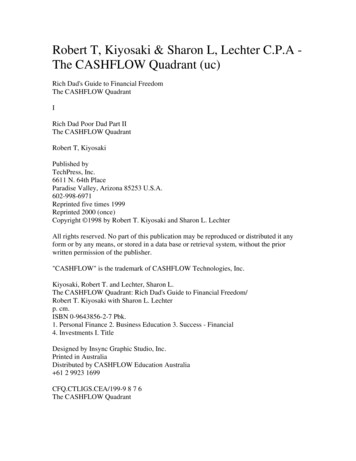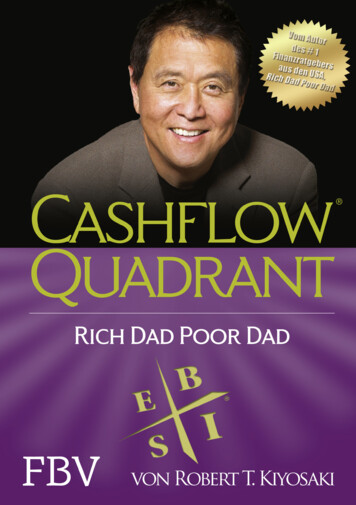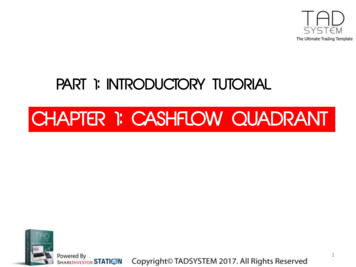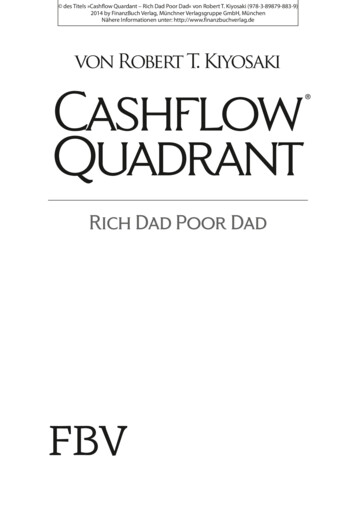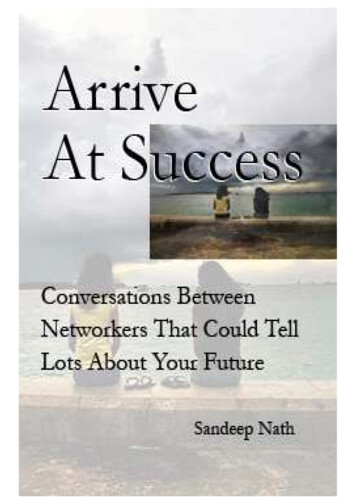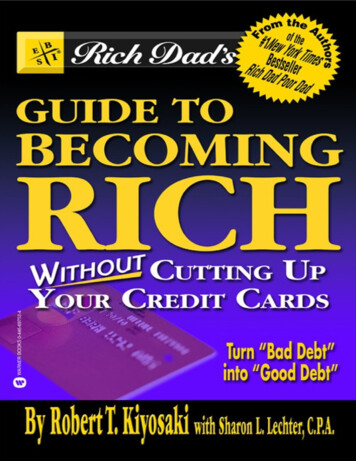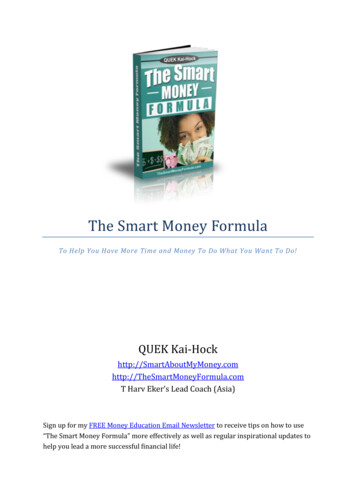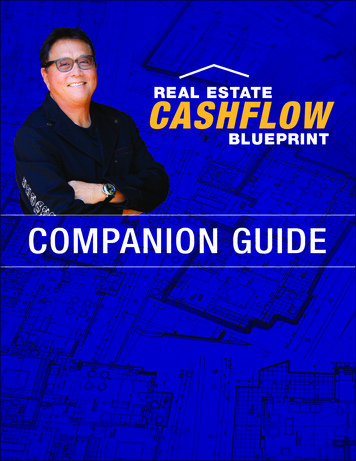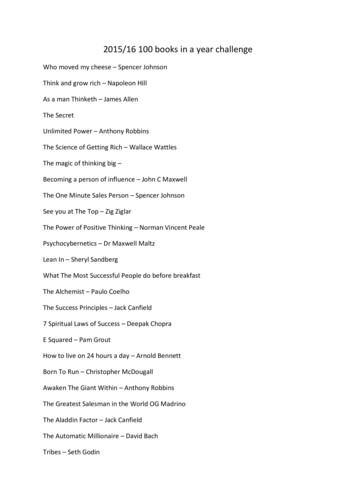
Transcription
Robert kiyosaki cashflow quadrant free pdf pc
SaveSave for later Cashflow Quadrant pdf free download. In preparing the 2011 edition of Rich Dad’s Cashflow Quadrant pdf free download Robert realized two things: that his message and teachings have withstood the test of time, and that the investment landscape, the world in which investors operate, has changed dramatically. Cashflow Quadrantpdf free download Download Book Please make a comment if the link is not working for you. I appreciate your valuable comments and suggestions. For more books please visit our site. Admin The CASHFLOW Quadrant represents the different methods by which income or money is generated Different methods of income generation requiredifferent technical skills, different educational paths, and different types of people.” Robert Kiyosaki, Cashflow Quadrant The Cashflow Quadrant. It’s the main idea of Robert Kiyosaki’s book by the same name. And it’s a powerful one that has guided much of my own entrepreneurial path to seek financial freedom. As you can see, each quadrantrepresents a different way to generate income. Some people earn money in only one quadrant, while some people earn money in all four. There are advantages and disadvantages to each. But the two quadrants on the right side (B & I) are the primary paths to financial freedom. The majority of Kiyosaki’s book teaches the unique skills and mindsetsrequired to succeed on this path. A course by Coach Carson that teaches you how to run the numbers so that you can confidently analyze and buy profitable rental properties. It also includes Coach’s rental analysis spreadsheet. Get the Course Let me explain a little more about each of the four quadrants: E – Employee An employee has a job. This iswhere most people earn their income. The job itself is owned by a business, which could be a single person or a large corporation. The employee gives his or her time, energy, and skills to an employer in exchange for a pay check and benefits. Employees can make a little or lot of money. But when an employee stops working (or when the businessstops), their income stops, too. This long-term lack of control over income is the primary problem of the E quadrant. An employee’s financial destiny, security, and freedom is dependent upon the whim and the success of their employer. S – Self-Employed Many employees get tired of their lack of control and choose to work for themselves. The selfemployed still work, but they own their job. The S quadrant includes dentists, insurance agents, restaurant owners, realtors, handymen, and many other trade workers. Many self-employed people earn very large incomes, but like the employee, when they stop working so does their income. Self-employed people do have a lot more control than anemployee, but that also means they have more responsibility. As a result, success usually means working harder and working longer. Over the long run this can lead to burn out and fatigue. B – Business Owner Those in the B quadrant own a system and lead people. The systems and people who work for the business can run successfully without thebusiness owner’s constant involvement. The same types of businesses could be run by S owners and B owners. For example, a plumber could own and work in his own plumbing business, or a business owner could create a plumbing business and hire quality plumbers, administrators, and a manager to run the systems of the plumbing business. Thewealthiest individuals in the world typically own businesses. These include Bill Gates of Microsoft, Jeff Bezos of Amazon, and Mark Zuckerberg of Facebook. I – Investors Investors own assets that produce income. This is the quadrant for truly passive income. Investors in this quadrant have usually accumulated money earned in one or more of theother three quadrants, and they let the money go to work and produce even more money for themselves. Investors often purchase shares of companies owned by those in the B quadrant. The capital from the investors helps to fuel the systems created by the business owner, and this fuel can lead to even greater growth (and more income) for everyoneinvolved. There are multiple paths to financial independence, but most of them ultimately lead to the right side of the quadrant – B and I. So, if you want to achieve greater financial independence and freedom, it will pay to start learning the skills and mindset required to make this move to the right side. Which quadrant represents you? Where do youearn most of your income? What about your spouse? Your friends? Which part of the cash flow quadrant would you like to move to first? I’d love to hear from you in the comments section below. Enter your email address and click "Get Toolkit" Success! Now check your email to confirm your subscription. Rich Dad's CASHFLOW Quadrant is a guide tofinancial freedom. It's the second book in the Rich Dad Series and reveals how some people work less, earn more, pay less in taxes, and learn to become financially free. CASHFLOW Quadrant was written for those who are ready to move beyond job security and enter the world of financial freedom. It's for those who want to make significant changesin their lives and take control of their financial future. Robert believes that the reason most people struggle financially is because they've been spent years in school but were never been taught about money. Robert's rich dad taught him that this lack of financial education is why so many people work so hard all their lives for money.instead oflearning how to make money work for them. This book will change the way you think about jobs, careers, and owning your own business and inspire you to learn the rules of money that the rich use to build and grow their wealth. Download Rich Dad’s Cash Flow Quadrant PDF book free – Rich Dad’s Cash Flow Quadrant PDF: There was an importantdiagram my rich dad showed me when I was a little boy. It was a diagram known as the Cash Flow Quadrant. And the Quadrant is made of four different people who make of the business world. Buy from Amazon So my rich dad said, “In the business world there are Es and E stands for employees. And the employees, you can always tell who they areby their core values. An employee with the president, the generator of the company, will always say the same words. The words are, “I’m looking for a safe, secure job with benefits.” That’s what makes them employees because their core value is security.” Rich Dad’s Cash Flow Quadrant PDF The other one of the four is the S for the small businessowner or the self-employed and again their core values will cause them to use the same words which are, “If you want it done right, do it by yourself.” S means they are also solo. Generally one person act, they operate by themselves This text, the follow-up to Rich Dad, Poor Dad reveals why some people work less, earn more, pay less in taxes, and feelmore financially secure than others. The author argues that it is simply a matter of knowing which quadrant to work from and when. Rich Dad’s Cash Flow Quadrant PDF Have you ever wondered: What is the difference between an employee and a business owner?; Why do some investors make money with little risk while most other investors justbreak even?; Why do most employees go from job to job while others quit their jobs and go on to build business empires?; Why, in the Industrial Age, did most parents want their children to become medical doctors, accountants, or attorneys. and why, in the Information Age, are these professions under financial attack? Review – Rich Dad’s Cash FlowQuadrant PDF This book gets your mind on the right track, but doesn’t teach you. Many that buy his books believe they will be taught how to do things. This isnt real education, as he doesnt tell you how to do anything. He just gives concepts like “Find ways to provide income for yourself so that you dont have to work.” DUH, that’s why we have thebook. What he really wants is for you to keep buying his books and getting vague concepts, buy his game, and pay for his school. Rich Dad’s Cash Flow Quadrant PDF He mentions at the end of this book his specialty is marketing consider that. Also, you’ll realize a lot of the book is him repeating himself b/c he is trying to fill a book, similar to a highschool essay that needs to reach a certain amount of pages. Lastly, early in the book he shames people for using financial advisors saying advisors don’t know what they’re talking about then in the last chapters he admits he has advisors in every category and they play a huge part in his cash flow and business decisions. (eye roll) THE 20 MOSTIMPORTANT INSIGHTSEveryone can be classified as an employee, self-employed, business owner, or investor, depending on how they make money. Each of the four quadrants has its own set of strengths, limitations, and traits. Employees, or the E-quadrant, place a premium on security and seek the stability of a long-term contract. To make money,this person works within someone else’s system. The S-quadrant, or self-employed person, does not want their income to be reliant on others. They are likely a diehard perfectionist who values independence and skill, and they essentially own their profession. The riskiest quadrant is self-employed. Nine out of ten such enterprises fail during the firstfive years in the United States, owing to a lack of experience and funding. The key to success in this S-quadrant is knowing when to leave and try something new. The business owner, or B-quadrant, has a system in place where others perform the work for him, such as Henry Ford, who surrounded himself with smart people who knew all the answersso he could focus on new ideas. The I-quadrant, or Investor, uses money to make money. The I-quadrant is where genuine wealth can be found. Investors in the E- and S-quadrant stock markets place a premium on diversification. Diversification, on the other hand, is a strategy to avoid losing money rather than a way to earn money, as Warren Buffettsuggests. Focusing on a few investments rather than diversity is a superior strategy. “Wall Street is the only location where folks ride in a Rolls Royce to obtain advise from people who use the subway,” Buffett says. Don’t trust a “expert” with your investment selections. The safe side of the quadrant is on the right. You don’t have to be concernedabout unemployment if you have a safe system that generates income for you. The key to prosperity is the same as winning Monopoly: purchase four green houses and then trade up for a massive red hotel. Your mortgage is a burden and a debt that you must pay back, not a valuable asset. Even if you pay off your mortgage, your home remains aliability since it must be maintained and taxes must be paid. Only if a property creates positive cash flow is it considered an asset. Gold isn’t always the best investment: “Even gold is an asset if you acquire it for less than you sell it for.” Moving from quadrant E or S into quadrant B, and then into quadrant I, is the best way to achieve financialindependence. A financially successful business owner will have the skills, time, and financial resources to support the Investor’s ups and downs. When you work hard to earn money that you subsequently squander, you don’t become wealthy; instead, you become exhausted. For years, Kiyosaki lived simply and worked hard to accumulate assetsrather than pay expenses. People who are afraid of losing money buy a stock at 20 and then sell it when the price rises to avoid losing what they have acquired. They also stay on when the price drops to 5 in the hopes that it will rise again. The Investor is unconcerned about victories and losses, and will only sell a stock once it has reached its top orhas begun to fall. Write down where you want to be financially one year and five years from now to get started on your path to financial freedom. To illustrate all of your income, expenses, assets, and obligations, create personal income and balance sheet statements. Set aside 150- 200 per month to pay off credit cards, auto payments, andeventually your mortgage to get rid of your consumer debt. In five to seven years, the majority of people can be debt-free. Put the money you used to pay down your debts into assets that will pay you back. Make an effort to educate oneself. Read the Wall Street Journal, listen to financial news, read financial websites, periodicals, and newsletters forat least five hours a week, or attend investment and financial education seminars. Become an expert in a specific problem type. Bill Gates is a software marketing expert who has solved numerous problems. Warren Buffett is a stock market specialist who has addressed numerous challenges. Kiyosaki rose to prominence as an expert in the field ofapartment living. Invest in assets that will give you with long-term or passive income. Begin with little increments, such as Monopoly’s “green houses,” and work your way up to greater stakes. There are 4:40 minutes left in the game.Enter your your address to have access to our library of 500 business resources, as well as weekly updates:Pleaseenter your email address here. SUMMARYThe Cashflow Quadrant divides people into four categories based on their source of income: employee, self-employed, business owner, and investor. Owning a business where other people do the job for you or being an investor who utilizes money to earn more money gives you the most freedom. If you shiftyour mindset about money and risk, you can go from being an employee or self-employed to being a business owner or investor. Make a strategy to take control of your spending and reduce your debts and liabilities. Start saving a tiny bit each month and live within your means. Become financially literate and an expert at fixing a specific companychallenge. Concentrate on accumulating assets that will provide you with passive or long-term income. Take small moves in the direction of your objective. Seek for mentors, learn from your mistakes, and have faith in yourself. WHERE DOES THE CASHFLOW QUADRANT COME FROM?Kiyosaki’s well-educated father advised him to aim for the E or Squadrants when he was younger. However, his father, who spent his whole life in these quadrants, was always destitute. Kiyosaki’s best friend, on the other hand, had a father who was a high school dropout who had made it to the B and I quadrants and was wealthy. This “wealthy father” was the one who explained the Cashflow Quadrant. TheCashflow Quadrant, at its most basic level, is a system for categorizing people based on where their money comes from: E, S, B, or I. Employees, or those who work for a living, are represented by the letter E. S is a self-employed someone who works for oneself. B stands for business, and it refers to someone who owns a business or a system thatcreates revenue. And I’m an investor, which means that I make money from my numerous assets. We all fall into at least one of these quadrants, and members of each share common features as well as distinct strengths and shortcomings. You can find financial freedom in any of the four quadrants, and you can be rich or impoverished in any of them,but the abilities required in quadrants B and I will help you get there faster. EMPLOYEEThe Employee is concerned about his or her safety above all else. They despise the worry that accompanies economic uncertainty. It doesn’t matter if the employee is a janitor or a CEO; what matters is that they want the security of a long-term contractualcommitment. Employees prefer to focus on money rather than possessions, and to acquire that income, they work within someone else’s system. SELF-EMPLOYEDThe self-employed individual prefers to be their own boss and does not want to rely on others for their livelihood. They expect to be paid more if they work more, and they are adamantabout their financial independence. Unlike the E, the S responds to fear by taking control and doing it themselves, rather than seeking security. The S is a perfectionist who loves independence and being recognized as an expert in their profession. An S is the system that produces money and essentially owns a job. This is, in many respects, the mostdangerous region. Failure is common, and success necessitates working even harder and for longer periods of time. Nine out of ten such enterprises fail during the first five years in the United States, owing to a lack of experience and funding. The clever S sells their firm at the zenith of its performance, before it runs out of steam, to someone withenergy and money, then takes the proceeds and starts something new. Knowing when to leave the S quadrant is crucial to success. OWNER OF A COMPANYUnlike the self-employed person, the business owner prefers to surround themselves with others who will do the work for them. A prime example of a B quadrant is Henry Ford. It’s a well-knownanecdote about how several academics condemned Ford, claiming he didn’t know anything. Ford invited them to come up to him and ask him anything they wanted. The intellectuals peppered him with questions. When they were finished, he summoned his most capable assistants to provide the answers. He informed the intellectuals that he employedthe brightest people to come up with answers so that he could focus on more essential responsibilities, such as thinking. The major difference between a S and a B is that a successful B can leave the company for a year and come back to find it still profitable. The B owns or controls a money-making system. Many people feel, for example, that they canproduce a better burger than McDonald’s. McDonald’s, on the other hand, isn’t just about the burger; it’s also about the system that produces and serves the burger. Bill Gates did not create a fantastic product; instead, he purchased one and established a powerful global system around it. INVESTORWith money, the investor makes money. The Iquadrant is the rich’s playground, where money is exchanged for wealth. Money works for you in the I quadrant. Investors of various types Some investments, such as receiving an education or putting money into a retirement plan, aren’t really appropriate for the I quadrant. The I quadrant, on the other hand, is about assets that create income on aconsistent basis throughout your working years. In an ideal world, everyone should invest in the I quadrant, where they can generate more money. Many people are hesitant to begin investing because they are concerned about taking risks. They want to be safe by putting their money in a bank or entrusting their investments to a professionalinvestment manager. However, the majority of these “experts” are actually employed in the E-quadrant. “Wall Street is the only location where people ride in a Rolls Royce to get advise from folks who use the subway,” Warren Buffett said. There are 4:40 minutes left in the game.Enter your your address to have access to our library of 500 businessresources, as well as weekly updates:Please enter your email address here. When you “invest” in a pension plan, you don’t see your money for a long time. Someone in the Investor quadrant does not park their money; instead, they swiftly recuperate it and put it back to work. Many of today’s stock market investors are in the E and S quadrants, whoare, by definition, security-oriented and believe in concepts like diversification. “Diversification is a strategy not to lose money, not a way to earn money,” Warren Buffett argues. He believes that focusing on a few investments rather than diversity is a superior strategy. LIABILITIES AND ASSETSLearning how to handle risk is crucial to becoming asuccessful investor. You must obtain a financial education in order to invest with your brains rather than your eyes or emotions. Being financially knowledgeable, for example, involves understanding that a mortgage is a liability, a loan that must be paid back. Your mortgage is a bank asset, not a personal asset. Even if you pay off your mortgage, yourhome is still a liability since it must be maintained and property taxes must be paid. Only if a property creates positive cash flow is it considered an asset. Any debt is a liability, whereas your savings are an asset. “Even gold is only an asset if you purchase it for less than you sell it for,” Kiyosaki’s Rich Dad tutor put it. THE BEST WAY TO GOMovingfrom quadrant E or S into quadrant B, and then into quadrant I, is the best way to achieve financial independence. A financially successful B will have the expertise, time, and resources to help the I through its ups and downs. Quadrant B’s goal is to own a system and have people manage it for you. There are three major methods for accomplishingthis. The classic C-corporation, in which you create your own system, is the first option. The second option is to buy a franchise of an existing system—this can be difficult for someone with an S-mentality who wants to do things their own way, but it is still a good opportunity to learn a lot about running a business. The third option is networkmarketing, often known as direct distribution marketing, in which you join an existing system. This can be a good method to start investing; just make sure you choose a network marketing company that is focused on teaching and assisting you in your success, as well as one with a solid track record and a strong mentorship program. CHANGINGYOUR IDENTITYThe most difficult aspect of moving from the left side of the quadrant, the E and S side, to the right side, the B and I side, is changing your perspective on money. THE QUADRANT’S DANGEROUS SIDEThe quadrant’s left side is the most dangerous. As an E, you are financially reliant on someone else. You are reliant on the opinion ofothers if you are not financially informed. The quadrant’s right side is the safe side. You don’t have to worry about losing your job if you have a secure system that generates money for you; if simply want more money, you expand the system and recruit additional people. PLAY MONOPOLY ONLINEWhen people ask how he became wealthy, Kiyosakialways responds that he used to play Monopoly as a kid. He learned from the game that the best way to win is to buy four green houses and then upgrade to a massive red hotel. In his life, the same rule applied. When the housing market was weak, the author and his wife acquired as many tiny houses as they could with the money they had. Theytraded up when the market improved, and today the cash flow from their enormous red hotel, apartment houses, and mini-storage units covers their expenses. The thing that needs to alter in order to go from the left to the right side of the Cashflow Quadrant is not what you do, but how you think. Working hard to get money to spend on things doesnot make you wealthy; it simply makes you exhausted. For years, Kiyosaki lived simply, focusing his efforts on accumulating assets rather than paying debts. When it comes to moving from the left side of the quadrant to the B or I side, Kiyosaki advises starting small with modest green residences, taking their time, and only moving on to big red hotelsonce they’ve earned some confidence and expertise. RATIONALIZE YOUR THOUGHTSMoney has an emotional component to it. Take a look at the stock market, which is dominated by greed and fear. Stop thinking emotionally about money; don’t focus on how you feel or, more importantly, what you dread. Keep in mind that failure is unavoidable.You’ll eventually stop worrying about failing because you’ll know you can always get back up. People are especially fearful of losing money, so they will buy a stock for 20 and sell it at 30 to avoid losing their gains; yet, if they had hung on for longer, the stock would have hit 100 or higher. The same folks will stay on to a 20 stock when it falls to 5 in the hopes that the price will rise again. A winner follows the opposite approach: they sell and take their losses as soon as a stock begins to decline. They stay on to a rising stock until it reaches its peak. To put it another way, the secret to becoming a great investor is to operate logically and remain unaffected by winning or losing. FINANCIALSUCCESS IN SEVEN STEPSKiyosaki highlights the necessity of taking baby steps on the road to financial success: “Before you can run, you have to walk.” However, it’s also crucial to remember Nike’s tagline, “Just do it.” Make a rough sketch of your large goal, then start taking incremental steps toward it while learning as much as you can. Thereare 4:40 minutes left in the game.Enter your your address to have access to our library of 500 business resources, as well as weekly updates:Please enter your email address here. STEP 1: BE CONCERNED WITH YOUR OWN BUSINESSTo begin, create a personal financial statement. Write down your financial goals for the next five years, as well asa shorter-term goal for the coming year. Make sure your objectives are attainable. “In five years, I hope to raise my monthly income from assets to xx,” for example. I intend to reduce my debts by xx in a year.” Make an income statement and a balance sheet for yourself, detailing your current sources of income and spending, as well as all of yourassets (savings, investments, real estate, and so on) (mortgage, loans, etc.). STEP 2: MANAGE YOUR MONEY FLOWExamine your financial statements from Step One. Today, your revenue comes from which sector of the Cashflow Quadrant? In five years, where do you want the majority of it to come from? Make a two-part cash-flow management plannow. To begin, set away a portion of each paycheck into an investment savings account and don’t touch it until you’re ready to invest. After that, concentrate on minimizing your consumer debt. Every month, use only one or two credit cards and always pay off new charges. Find a way to make an extra 150- 200 each month and use it toward payingoff one of your credit cards. Move on to the next card after you’ve paid off the previous. Accomplish the same with your car and house payments once your consumer debt is paid off—most people can do this in five to seven years. Once you’re debt-free, apply the money you used to pay off your last loan toward investments that will help you expandyour asset column. STEP 3: EDUCATE YOURSELFUnderstand the difference between a liability and an asset. An asset, at its most basic level, is something that generates cash flow into your wallet; a liability, on the other hand, generates cash flow out of your pocket. Spend five hours every week reading the business part of your newspaper and theWall Street Journal, listening to financial news on TV or radio, reading financial websites, periodicals, and newsletters, and attending investing and financial education seminars. STEP 4: TEACH YOURSELF HOW TO SOLVE PROBLEMSInvestors who are financially uninformed search for “experts” to advise them what to invest in, whereasknowledgeable investors specialize in solving a certain sort of problem. Bill Gates, for example, is an expert at resolving software-marketing issues. Warren Buffett is a guru when it comes to resolving business and stock market issues. Kiyosaki and his wife are professionals when it comes to resolving issues with apartment living. Continue to educateyourself. If you’re looking for apartment dwelling, for example, look for For-Sale signs in your area. Call the agent and inquire about the current rent and maintenance fees, as well as the various financing options available. Calculate the cash-flow statement for each property on a monthly basis. Attend financial lectures and classes once a week, andread investment periodicals. Look into the firms that stockbrokers recommend and consider creating a trading account to make some little investments. Meet with local business brokers to find out what’s for sale. Attend trade shows to learn about franchises and network marketing opportunities in your area. STEP 5: SEARCH FORMENTORSKiyosaki’s Rich Dad tutor instructed him to concentrate on passive income and invest in assets that provide passive or long-term residual income. Remember that most people who give financial advise are in the E or S quadrants themselves, so choose your mentors wisely. People in the investment and business quadrants should be soughtout. STEP 6: LEARN FROM YOUR FAILURESExpect to be disappointed, and have a mentor on hand to assist you if you run into financial difficulties. Be gentle with yourself; if you punish yourself for every setback, you’ll never learn anything new. Above all, get started! You can’t advance unless you take action—make real estate offers, join a networkmarketing organization, or invest in a stock you’ve researched. Just remember to take little steps at first and to accept that making mistakes is a necessary part of the learning process. STEP 7: HAVE FAITH IN YOURSELF.Listen to your worries and doubts, then explore further to uncover the truth. “I’m too exhausted to learn something new,” youcould think. “If I don’t learn something new, I’ll be much more fatigued,” the fact is. “If I learn something new, I’ll get thrilled about life again,” says the deeper truth. Details About Cashflow Quadrant by Robert T. Kiyosaki PDF Name: Cashflow Quadrant: Guide to Financial FreedomAuthors: Robert T. KiyosakiPublish Date: 2011Language:EnglishGenre: BusinessFormat: PDFSize: 7 MBPages: 360Price: FreeISBN: 1612680062 Robert Kiyosaki, author of Rich Dad Poor Dad – the international runaway bestseller that has held a top spot on the New York Times bestsellers list for over six years – is an investor, entrepreneur and educator whose perspectives on money and investing fly in theface of conventional wisdom. Rich Dad’s Cash Flow Quadrant PDF He has, virtually single-handedly, challenged and changed the way tens of millions, around the world, think about money.In communicating his point of view on why ‘old’ advice – get a good job, save money, get out of debt, invest for the long term, an
SaveSave for later Cashflow Quadrant pdf free download. In preparing the 2011 edition of Rich Dad's Cashflow Quadrant pdf free download Robert realized two things: that his message and teachings have withstood the test of time, and that the investment landscape, the world in which investors operate, has changed dramatically.
